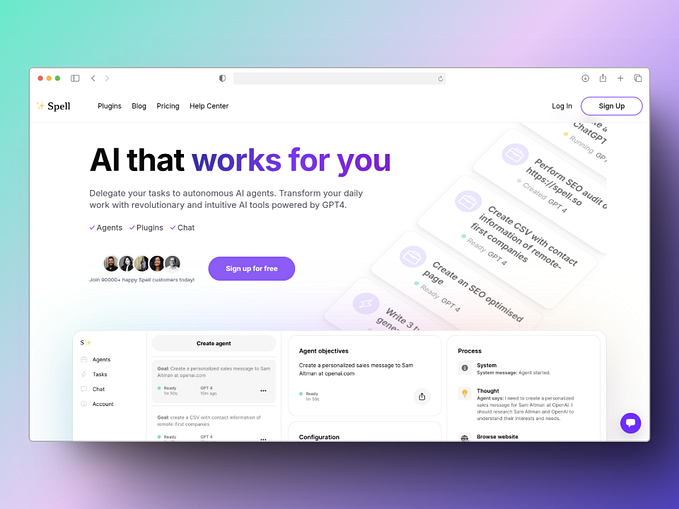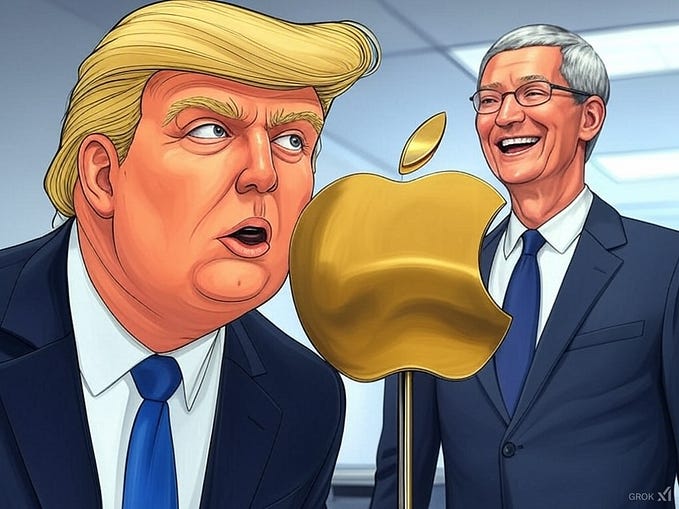The Bit Short: Inside Crypto’s Doomsday Machine
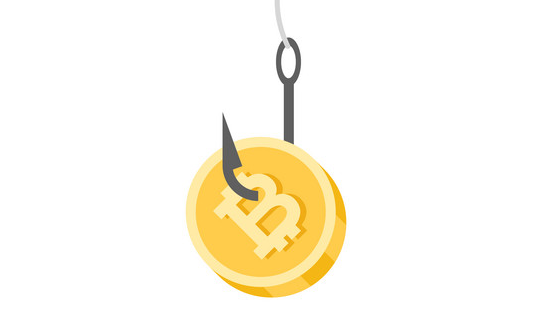
This is the story of a Bitcoin trade — the most financially impactful trade I’ve ever made in my life. It’s also the story of the deep-yet-frantic investigation of the crypto ecosystem that led me to make that trade. And it’s the story of what’s really going on in crypto — and what we should do about it.
If you own meaningful amounts of cryptocurrency or you’re considering buying some, you’re the reason I wrote this. Please do read to the end.
Prologue: Tether & company
Before I begin this story, there’s a bit of background you need to know first.
There are things in crypto right now called Tethers. To simplify a bit, Tethers are issued by a crypto company called Tether Ltd. — meaning that if Tether Ltd. says you own a Tether, then you do.
Tether Ltd. also says one Tether is worth exactly one US dollar. Can they do that? Well they say they can, because they hold $1 worth of assets for each Tether. But are those assets actual dollars? No, they are not. So what if the assets go down in value? Don’t worry; they will not. Okay, but can we at least see the assets? No, you may not.
Who in their right mind would use something like Tether? Well, the short answer is that many people use Tethers to buy Bitcoin and other cryptocurrencies. The long answer, though, is astounding — but more on that later.
Because Tether sounds exactly like a currency fraud, it may not surprise you to learn that Tether Ltd. is currently under investigation by the Office of the Attorney General for the Southern District of New York. That investigation was announced to the public on April 25th, 2019.
The trade
Now fast-forward one year. In March of 2020, I bought a large amount of Bitcoin. At the time, I saw a market dislocation and the likelihood of significant dollar inflation due to the US Government’s likely response to the unfolding pandemic.
I suspected Bitcoin would be inflation-resistant because of its enforced scarcity. To the extent that I thought about Tether at all, I remembered the OAG’s investigation, assumed Tether was now old news and would surely have been pulled from the markets, and dismissed it as a factor in my buying decision.
That was a huge mistake.
The HODL
For the rest of 2020, my inflationary thesis looked right. Unrest in the United States, combined with anticipated high levels of lending and consumer spending post-pandemic, seemed likely to fuel substantial USD inflation in real terms through the end of 2021. During the same period, Bitcoin was becoming increasingly scarce on a secular basis.
The market appeared to agree with my thesis. My Bitcoin position doubled in value, then doubled again. By the end of the year I was sitting on a 600% gain, and decently wealthy in nominal dollars.
I had intended to hold my Bitcoin for the very long term — it never even crossed my mind to sell it, regardless of its day-to-day price variations.
And then, in early January, a forum post caught my eye.
The shock
On January 8th, I saw this post on Hacker News about Tether manipulating the price of Bitcoin. That shook me: I’d assumed Tether had been purged from the crypto markets, yet apparently it was still around. But how much Tether could there really be in the crypto markets? Surely not that much.
Still, I took a look. The answer, I was surprised to see, was a lot:
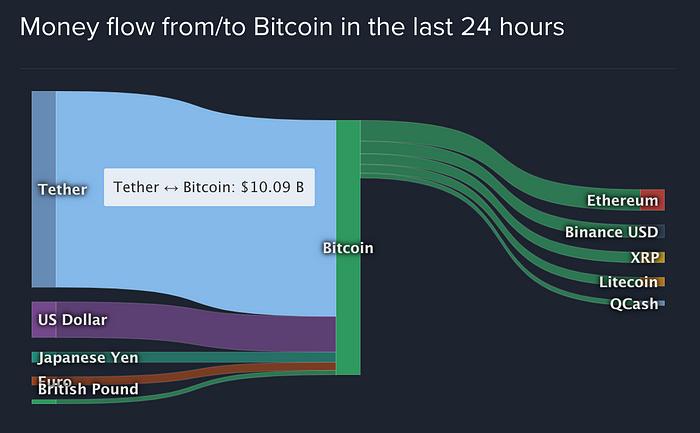
The left-hand side of this chart shows which currencies are flowing into Bitcoin (that is, are being used to buy Bitcoin) across all crypto exchanges. The right-hand side shows which currencies are flowing out of Bitcoin (that is, that Bitcoin is being used to buy). The chart is showing typical numbers for early January 2021.
The upshot: over two-thirds of all Bitcoin — $10 billion worth of it — that was bought in the previous 24 hours, was being purchased with Tethers.
What’s more, this pattern wasn’t unique to Bitcoin. I saw the same thing for all the other popular cryptocurrencies:
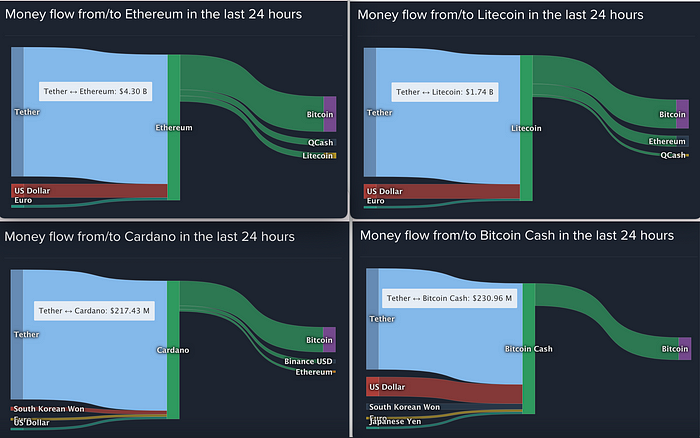
It seemed I’d been wrong to dismiss Tether. Tether wasn’t just in the crypto markets — Tether was the crypto markets.
The panic
This worried me. Most of my wealth was exposed in the form of Bitcoin, and Bitcoin seemed like it might be exposed to Tether. And Tether’s issuing company was under active investigation. I urgently needed to find out if this risk was real.
I cleared my schedule and started digging. Right away it was obvious that if Tether flows were partly or wholly fraudulent, that would have a significant effect on the correct market price of Bitcoin. (Even though $10B of Tether flows only constitutes 1.4% of Bitcoin’s $700B nominal market cap, all that really matters is what fraction of Bitcoin’s daily buying volume Tether accounts for — and that number is closer to 70%.)
How could I find out if Tether was fraudulent? One quick proxy might be what kinds of exchanges it traded on. I knew that some exchanges, like Coinbase, used solid due diligence to curb money laundering, while many other exchanges weren’t as well-run. Was there a pattern to which exchanges supported Tether and which didn’t?
There was. Here’s how crypto trades flow through Coinbase Pro in a typical 24-hour period:
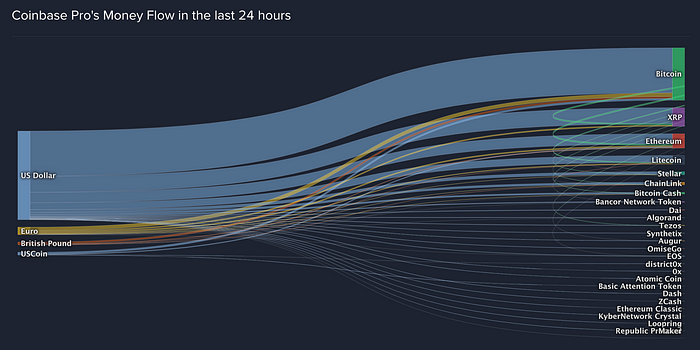
Notice that the money going into crypto is almost all dollars, Euros and British pounds — currencies that are subject to rigorous controls by their countries’ respective authorities.
And here are the flows of crypto trades through Binance, Bit-Z, and HitBTC — the three biggest crypto exchanges in the world by nominal volume:
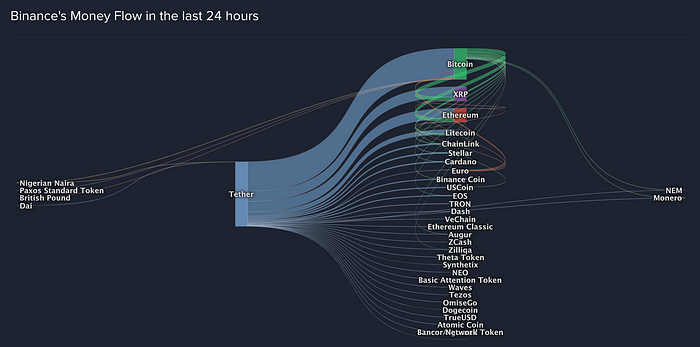
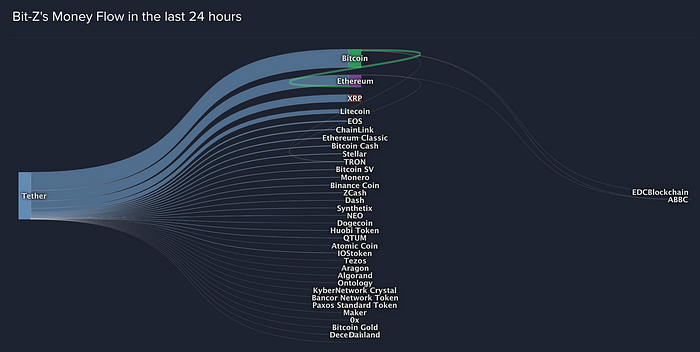

The pattern was obvious. Practically all the crypto sold on these three exchanges was being bought with Tethers. None at all was being bought with USD.
And the volumes were huge. Coinbase Pro is responsible for around $4B in crypto trades each day. But Binance alone accounts for over $50B worth of crypto volume, and each of the other two exchanges is bigger than Coinbase. Most of the crypto that gets bought each day, is getting traded for Tethers on those three exchanges.
Binance, Bit-Z and HitBTC are “unbanked” exchanges. That means they don’t have direct access to the US financial system — most likely because no US institution is willing to serve as their correspondent bank domestically. (Binance US, an affiliate of Binance, does allow dollar purchases. But its daily volume is only 10% that of Coinbase — and less than 1% that of its offshore counterpart — so its effect on the crypto markets is negligible.)
It’s hard for crypto exchanges to get banked, but Coinbase, Bitstamp, and several other high-quality exchanges manage it by maintaining strong know-your-customer (KYC) and anti-money-laundering (AML) controls internally.
But what I found most alarming was that neither of the two most reputable USD-banked exchanges — Coinbase and Bitstamp — supported Tether trades at all. If Tether was on the level, there’d be no reason for them to forego the fees on that trading pair — unless their risk and compliance departments had deemed the token too much of a liability to carry.
The deep dive
By now, I was concerned that my Bitcoin position might be too risky to hold. But I still needed more evidence before I unwound such a big trade.
I had to get more context on Tether — context that was as free of marketing distortion as possible. I found what I was looking for in the case docket for the New York OAG’s ongoing investigation of Tether Ltd. (Note that the inquiry’s respondent is listed as “iFinex Inc., et al” rather than “Tether Ltd.” on the docket, for reasons that aren’t worth getting into here.)
I’ll skip most of the content — I strongly urge you to review the files for yourself — and just list the three biggest takeaways that jumped out at me:
- On February 26, 2019 — two months before opening its official investigation — the OAG requests a large number of documents from Tether Ltd. The purpose of the request is to help the OAG understand how Tethers are being issued, backed, and accounted for, and how Tethers are flowing through the crypto ecosystem.
- From the beginning of the official investigation on April 25, 2019, through to July 9, 2020 — a period of nearly 15 (!) months — Tether Ltd. issues a series of legal challenges to the investigation that appear designed to delay their response to the OAG’s document request.
- On July 9, 2020, the New York Supreme Court dismisses Tether Ltd.’s final challenge on appeal, effectively forcing Tether Ltd. to comply with the OAG’s document request. What’s more, Justice J. Gesmer’s opinion eviscerates all aspects of Tether Ltd.’s arguments (good commentary here), suggesting that Tether Ltd.’s appeal was never intended as a realistic challenge to the documentation request at all. But it could, plausibly, have been part of a strategy to delay the document disclosure by any possible means.
Things were looking bad. But then a question suddenly occurred to me: did any other significant event happen to Tether on or around July 9th, 2020?
So I looked. And I found something.
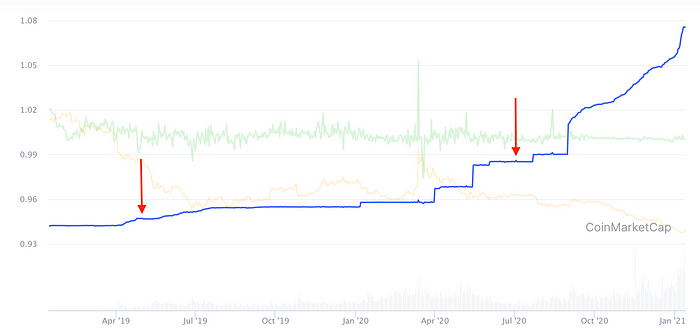
The chart above shows the market cap of all issued Tethers between January 13, 2019 and January 13, 2021 (the blue curve). Because one Tether nominally equals $1, the total market cap of Tether in dollars is always equal to the total number of Tethers. (The numbers on the y-axis don’t refer to the market cap. But for scale, the highest point of the blue curve corresponds to about $25B.)
The first red arrow on the chart points to April 25th, 2019: the announcement of the OAG’s investigation. Notice how, as the investigation progresses, the issuance rate of Tether begins to rise — initially in large single blocks, of around $1B, every few months.
The second arrow on the chart is July 9th, 2020: the date of the New York court ruling forcing Tether Ltd. to begin the process of disclosing its documents to the OAG. Two weeks after that ruling, Tether Ltd. issues one more large block of Tethers, nominally worth about $800M. And shortly after that — on September 1st — the issuance pattern for Tethers changes completely.
Beginning in September, Tether Ltd. begins to issue multiple large blocks of Tethers per day. The pace accelerates, with $2.3 billion worth of Tether issued in the first week of 2021 alone.
This was consistent with the possibility that, as Tether Ltd.’s various legal challenges failed one after another in the New York courts, Tether Ltd. was choosing to issue Tethers faster and faster to maximize the amount of value it could extract from the crypto ecosystem before being shut down. The pace accelerates closer to Tether Ltd.’s final disclosure deadline — January 15th, 2021.
I still needed to answer one last question. Did Tether issuance actually correlate with the price of Bitcoin? A glance at the charts gave me a clear affirmative answer:
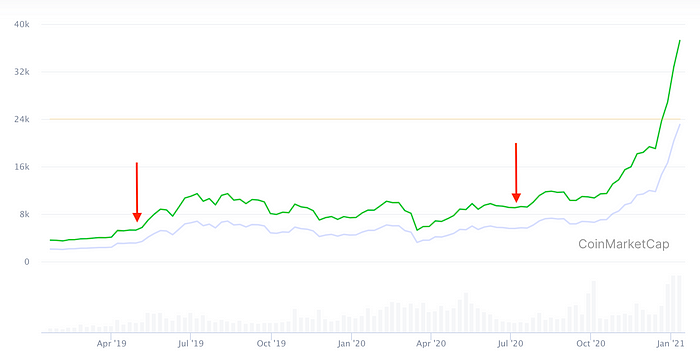
There are three major periods of high relative Tether issuance on this graph: 1) April 2019 through July 2019; 2) April 2020 through July 2020; and 3) September 2020 through to the present. All three periods overlap with visible increases in Bitcoin’s market price. (The red arrows here point to the same two dates as on the Tether chart above.)
This wasn’t a conclusive pattern: it still didn’t prove that Tether issuance was causing Bitcoin’s price increases. It was still possible that retail demand for Bitcoin was driving real USD into Tether Ltd. through some unknown mechanism; that Tether Ltd. was issuing Tethers in exchange for those dollars; and that those issued Tethers were then being used to buy Bitcoin. Under that scenario, Tether’s rise was being caused by Bitcoin’s demand, and Tether might be fully backed by dollars after all.
Nonetheless, based on this evidence, I concluded my risk was now too great. I was long Bitcoin up to my eyeballs; Bitcoin was clearly correlated with Tether; Tether was clearly being issued at a frantic rate; and that issuance had a high probability of being backed by nothing at all.
I made the call: it was time to get out.
The exit
On January 9th, 2021, I liquidated my crypto position for USD. In the process, I locked in a dollar-denominated gain that — in the interest of full disclosure — I can only describe as life-changing.
At this point, I still didn’t grasp the entire picture. For example, I still thought there was a chance Tether could be backed by real assets. My state of belief was something like: “Of the 70% of Tether flows into Bitcoin, some fraction is real; some fraction is real-but-illicit (e.g., buying drugs); and some fraction is pure fiction. I have no clue what the respective fractions of each are, but I do know that my personal risk threshold has been exceeded.”
I was still a bit concerned that I’d miscalculated. Tether might yet be largely real — and if it turned out it was, I’d have missed the boat.
And then, by pure luck, I had a conversation that blew my mind.
The epiphany
I was catching up with my friend Bob (pseudonym) over video chat. I’d just sold my Bitcoin position and was nervously awaiting confirmation from my bank that my USD wire transfer out of the exchange had cleared. Crypto was on my mind, so I asked Bob about it.
The conversation went something like this:
Me: You don’t own any crypto do you? I’m concerned some of the exchanges in the ecosystem might be fraudulent.
Bob: I actually have a whole bunch of crypto on this exchange called Bybit. Do you know if that’s one of the risky ones?
Me: I’m not sure. Does it let you trade in USD?
Bob: No, but a lot of other exchanges don’t either. In fact, you can’t even deposit USD directly into a Bybit account.
Me: Really? But then how do you get your money onto their exchange at all if they don’t accept USD deposits?
Bob: You send your USD to Coinbase and buy Bitcoin with it. Then you move your Bitcoin onto Bybit and trade with it there.
Me: Hang on. If that’s the case, then why would anybody ever use an unbanked offshore exchange that trades purely in crypto? What does Bybit offer you that Coinbase doesn’t?
Bob: Leverage. I personally only use 2–3X leverage, but they let you leverage your positions up to 100X if you want. You can’t do that on Coinbase.
Me: *Gasps audibly*
Bob: They also do a ton of promotions. They’ve got a bunch of timed missions where you can earn Tethers for doing stuff like inviting friends onto the exchange, joining their Telegram group, or trading on their platform.
Me: HOLY $#!@
Bob: But thanks for the warning! I’ll pull my crypto out as quick as I can. It might take me a few minutes though, I’ll need to fire up my VPN first.
Me: A VPN? But why, for the love of God?
Bob: Because I need to spoof a Bolivian ISP to access the exchange. They’re illegal to use if you’re based in America.
Me: *Head explodes*
There’s a scene in The Big Short where Mike Baum meets a stripper who’s taken out mortgages on five properties. The stripper doesn’t think there’s anything wrong with doing that, because her mortgage broker told her she could always refinance her mortgages when the prices of her houses went up. And housing prices would always go up.
Up to that point in the movie, Mike’s investigation had revolved around bonds, mortgage rates, and CDOs. But meeting that stripper personalizes the market for him: for the first time, Mike sees one of the human beings who’s on the other side of his mortgage trade. And that’s what finally convinces him to short the housing market.
For me, that’s what talking to Bob represented: for the first time, I’d seen what it felt like to be on the receiving end of crypto’s doomsday machine.
The smoking gun
Talking to Bob changed my perspective on Tether. I no longer viewed Tether as a source of excessive risk. I now viewed it as a highly probable fraud.
Part of the reason was incentives. The Tether-denominated amounts that Bybit, Binance, and other similar exchanges were giving away to people like Bob seemed inconsistent with the revenue those exchanges could expect to generate from an average user.
To get a sense of the giveaways, I ran an anonymized Google search for “Binance promotion”. This returned as one of its top results a binance.com page that read, in part, “We have a special end-of-the-year promotion where we will offer eligible users a Savings Voucher worth 500 USDT [Tether]!”
On the other hand, a similar search for “Coinbase promotion” returned zero first-page results hosted on the coinbase.com domain. This suggested that the offshore exchanges might be more willing to give away Tethers than Coinbase was to give away dollars, which implied the offshore exchanges were placing a lower value on Tethers than they should be.
Now that I knew what to look for, everything started falling into place. First I found this Twitter thread, pointing out that Tethers were being issued in exact, perfect-round-number blocks. (In the screenshot below, “USDT” is the ticker symbol for Tether.)

This is unusual: if demand for Tethers were real, one would expect Tether Ltd. to combine together multiple USD deposits from investors into a single issuing block. Combinations like that shouldn’t add up to perfectly round numbers every time. What’s more, the supposed USD inputs (e.g., 401,431,056 USD in the top left transaction) are giving perfectly round Tether outputs (e.g., 400,000,000 USDT in the same transaction) in every block — regardless of the prevailing exchange rate or anything else.
By itself, this is implausible. But when you compare it to the issuing pattern for USD Coin — Coinbase’s own issued stablecoin, which is backed by regularly audited reserves of real dollars — the difference is stark. (In the screenshot below, “USDC” is the ticker symbol for USD Coin.)
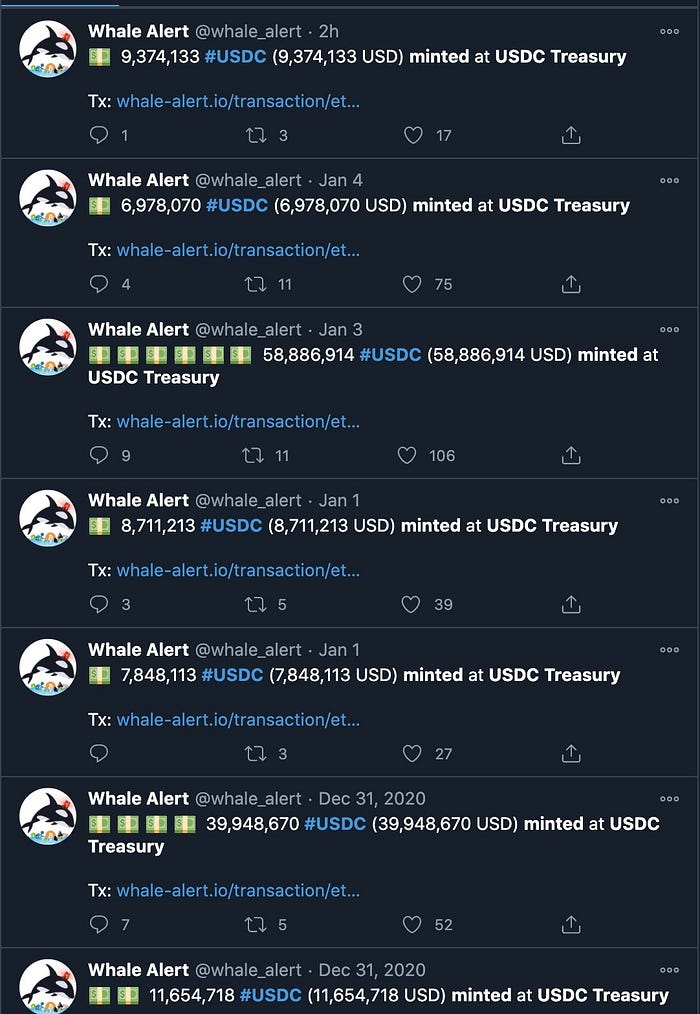
Coinbase issues its USD Coins very differently from how Tether Ltd. issues its Tethers. The issuing blocks for USD Coin are smaller, and their size varies more: Tether’s blocks range in size from 150M to 400M Tethers, while USD Coin’s blocks range from ~7M to ~60M USD Coins.
The issuing blocks for USD Coin also have random-looking numbers of coins in them (e.g., 9,374,133 USDC in the top transaction). That randomness is what you’d expect if Coinbase was pooling real USD demand from a bunch of unrelated investors together in each issuing block.
The last nail in the coffin was when I found out about the lack of visible reserves. If Tether Ltd. really was taking in 1 USD for each Tether it issued, then it should have as many dollars in its bank account as there are issued Tethers. And it turns out we can check if that’s true! Tether Ltd.’s bank is Deltec bank in the Bahamas, and the Bahamas discloses how much foreign currency its domestic banks hold each month.
The answer was — at least up to the end of September 2020 — not nearly enough:
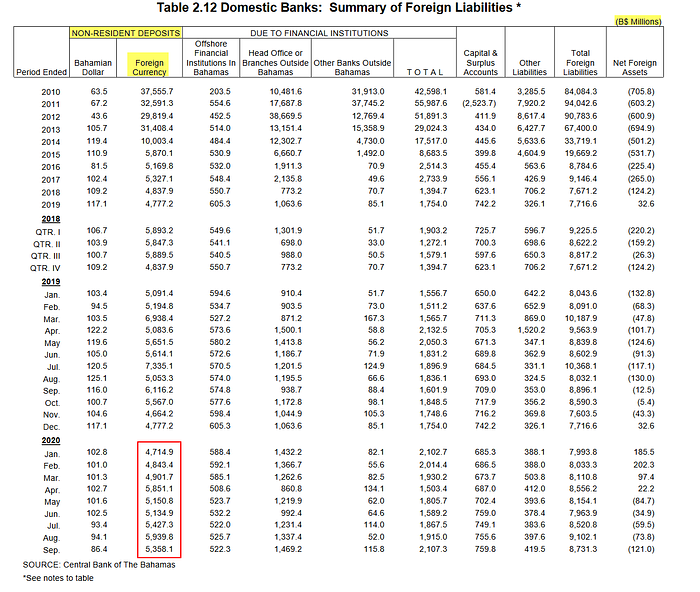
From January 2020 to September 2020, the amount of all foreign currencies held by all the domestic banks in the Bahamas increases by only $600 million — going from $4.7B to $5.3B. (The table is in Bahamian dollars, but the Bahamian dollar is pegged to the US dollar, so 1 BSD = 1 USD.)
But during the same period, total issued Tethers increased by almost $5.4 billion — going from $4.6B to $10B!
The implication was shocking: there weren’t nearly enough dollars in all the domestic banks in the Bahamas to back the Tethers that were floating around in the crypto market.
So this was crypto’s big short: Tether Ltd. was short of US dollars — to the tune of about $25 billion.
The big picture
After this latest round of research, I waited anxiously. I’d sold out of my Bitcoin position, but my bank wire was still in transit — I’d still face counterparty risk until I’d fully exited a market I was now convinced was built on a fraud.
While I waited, I combined what I knew of Bob’s experiences with my other evidence, which allowed me to build up a mental picture of the fraud’s core moneymaking engine. Here’s how it would work:
- Bob, a crypto investor, puts $100 of real US dollars into Coinbase.
- Bob then uses those dollars to buy $100 worth of Bitcoin on Coinbase.
- Bob transfers his $100 in Bitcoin to an unbanked exchange, like Bybit.
- Bob begins trading crypto on Bybit, using leverage, and receiving promotional giveaways — all of which are Tether-denominated.
- Tether Ltd. buys Bob’s Bitcoins from him on the exchange, almost certainly through a deniable proxy trading account. Bob gets paid in Tethers.
- Tether Ltd. takes Bob’s Bitcoins and moves them onto a banked exchange like Coinbase.
- Finally, Tether Ltd. sells Bob’s Bitcoins on Coinbase for dollars, and exits the crypto markets.
My guess is that Tether Ltd. (through proxy accounts) is only responsible for a small fraction of the direct buying activity on these exchanges. But with $50B in nominal value flowing through Binance every day, even a small slice of the flow represents huge amounts of revenue. And when your business involves trading fake dollars for real ones, your profit margins can get pretty high.
In the example above, Tether Ltd. bought Bitcoin from Bob at its nominal price in Tethers — but that Bitcoin was the cover charge Bob paid to get access to truly staggering levels of leverage and promotions from the exchange. And that very leverage, and those very promotions, are all denominated in Tethers — Tethers that I suspect Tether Ltd. is handing over to the exchange in huge quantities, to help it subsidize its user acquisition through more promotions.
This explains how Tether has been able to maintain its $1 USD peg on the unbanked offshore exchanges. For a given amount of Bitcoin, a crypto trader gains effective access to far more Tethers than the public exchange rate would justify. The exchanges then book those extra Tethers as “leverage” and “promotions”, allowing them to maintain the fiction that those “free” Tethers aren’t being traded for Bitcoin at all — even though they are part of the package Bob receives for the Bitcoin he sells.
Viewed from this angle, the fact that the offshore exchanges don’t support USD is a feature, not a bug: preventing USD and Tether from meeting on a transparent market is crucial for ensuring that the true price of Tether stays opaque — making it hard for an outsider to dispute its $1 peg.
Forget the activity on the offshore exchanges for a moment, and just think of a simple mental picture. Imagine you could stand at a metaphorical booth, where Coinbase’s exchange connects with the US financial system. If you could do that, you’d see two lines of people at the booth. One line would be crypto investors, putting dollars in — and the other line would be crooks, taking dollars out.
An hour after I finally wrapped my head around the whole, colossal mess, I got a notification from my bank. My wire transfer from the exchange had cleared.
I was out of the trade.
Epilogue: In the land of the blind
In my day job, I’m the founder of a fairly successful startup. As a result, my experience on Twitter is heavily weighted towards seeing posts by other founders and venture capitalists. By and large, these folks are well-meaning, highly intelligent, and deeply competent in their understanding of markets.
And yet, this selection of crypto tweets from the startup community is pretty typical:
These are well-respected members of the community. I’ve met a few of them personally and have always come away impressed — by their goodwill as well as by their insights. What’s more, I must admit I’ve expressed similar sentiments about Bitcoin myself in private, during this latest bubble.
So what’s going on here? What could be blinding our community to fraud on such a scale?
Part of the answer, I believe, is illiquidity.
An illiquid market is one you can’t cash out of quickly. The startup ecosystem is very illiquid: it takes years to decades for founders to cash out of the businesses they build. Startup founders — and the VCs who back them — mostly have experience dealing in illiquid markets.
Crooks don’t like illiquid markets. Crooks like being able to cash out fast: the longer they stay in one place, the higher the chance they’ll be caught and arrested, because they are crooks.
Since illiquid markets repel crooks, the illiquid startup ecosystem turns out to be largely (though not completely!) free from crooks. That’s part of what makes it such a pleasure to work in, but it also means that the community has never developed a great collective radar for fraud: it hasn’t needed one.
But the startup community has a fantastic collective radar for things that 1) start small; 2) grow fast; 3) challenge the status quo; and 4) are broadly misunderstood. Those are the features of a promising startup! And the community has learned that it’s expensive to miss out on one of those.
Unfortunately, those are also the features of a fraud. But the startup community doesn’t encounter much fraud, so it tends to discount the possibility — and in crypto, that’s a grave mistake. Unlike startups, crypto is a highly liquid market — exactly the kind that attracts crooks, and crooks like to do fraud. And that means that many things in crypto that look like promising startups, are actually frauds.
But it’s more than that: on top of everything else, crypto really is a promising technology. There’s value to decentralization and censorship resistance; there’s value to trustless enforcement of contracts; and there’s value to having a Schelling point for a scarce asset. The startup community is, correctly, recognizing that this potential value exists. But without good fraud radar, it has no way to estimate how much of that value is real today.
I believe the startup community is about to have its fraud radar recalibrated. That recalibration — and the exorbitant fee the market will charge for it — will be mandatory for anyone who holds a meaningful amount of crypto.
So where does all this leave us? There are a few remaining questions.
Can we break this fraud right now?
Is there a way for us to collapse this fraud quickly, so fewer people get hurt by it? I believe there is.
The legitimate crypto exchanges, like Coinbase and Bitstamp, clearly know to stay far away from Tether: neither supports Tether on their platforms. And the feeling is mutual! Because if Tether Ltd. were ever to allow a large, liquid market between Tethers and USD to develop, the fraud would instantly become obvious to everyone as the market-clearing price of Tether crashed far below $1.
Kraken is the biggest USD-banked crypto exchange on which Tether and US dollars trade freely against each other. The market in that trading pair on Kraken is fairly modest — about $16M worth of daily volume — and Tether Ltd. surely needs to keep a very close eye on its movements. In fact, whenever someone sells Tether for USD on Kraken, Tether Ltd. has no choice but to buy it — to do otherwise would risk letting the peg slip, and unmask the whole charade.
My guess is that maintaining the Tether peg on Kraken represents the single biggest ongoing capital expense of this entire fraud. If the crooks can’t scrape together enough USD to prop up the Tether peg on Kraken, then it’s game over, and the whole shambles collapses. And that makes it the fraud’s weak point.
To be crystal clear: every time you sell Tethers on Kraken, you are forcing Tether Ltd. to pay you in US dollars. If you can manage to sell enough Tethers for USD on Kraken, then Tether Ltd. will run out of dollars and this whole machine — which currently undergirds 70% of all crypto trading flows — will fall apart.
Well-capitalized hedge fund managers may wish to re-read the above paragraph, and ponder its implications.
How can we stop this from ever happening again?
I have a few suggestions.
The New York OAG should seek an injunction from the courts blocking any further issuance of Tethers. This should be done as soon as humanly (and legally) possible. Not only are the livelihoods of countless people on the line — including those of thousands of Americans and their dependents — but allowing a USD-equivalent pseudo-currency to be minted without backing or restriction puts the nation’s ability to regulate its own currency flows in jeopardy.
To be clear, US authorities should be extremely concerned about this. To a good approximation, there is currently an unregulated, foreign entity printing dollars with impunity. There’s a case to be made that this constitutes a direct, adversarial attack on the USD — and the longer it goes on, the more it risks impugning the integrity of the entire US financial system.
The US Treasury should enforce 100% reserve requirements on all USD-pegged crypto stablecoins, with mandatory audits. There is a lot of genuine potential in crypto — the startup ecosystem got this part right! — but that potential won’t be realized if the industry is riddled with frauds. And while over-regulation is a real concern, the fact that this racket has gone on for so long and at such a scale is a clear sign that we need a mechanism to validate the reserves of stablecoin issuers.
Healthy regulation makes an ecosystem more valuable, not less. Bitcoin might be trustless in itself, but if it’s being bought for fake dollars, its valuation in dollars will be fake as well. Whereas once we can trust that the dollars that go into Bitcoin are real, we’ll be able to trust that Bitcoin’s valuation is real, too.
Why did I write this?
Before my conversation with Bob, I was thinking about this problem in the abstract: there was a mystery to be solved; there was money to be made. But after speaking to Bob, I saw it differently: through the eyes of a real human being — one who had taken the wrong side of this trade.
There are millions of Bobs, all around the world. Many of them are leveraged up to their eyeballs in Tether on unbanked exchanges. Thousands more are buying into the trade every day. And almost all of them are going to lose their money when it all comes crashing down.
This would be bad enough in ordinary times. But during a pandemic, it’s catastrophic. Huge amounts of value for millions people will be wiped out — individuals, families, and the most vulnerable among us will be ruined at the worst possible time. This isn’t a game: the human pain will be immense. And the longer the fraud goes on, the more that pain will grow.
I wrote this to stop it.
Some of the source materials used in my investigation:
- Patrick McKenzie’s excellent blog post gives a clear picture of the Tether situation up to October 2019.
- Matt Levine dedicated an issue of Money Stuff to Tether.
- Cryptocompare has helpful historical data on the volumes of different currencies flowing into Bitcoin.
- I found the following Twitter accounts extremely insightful: @coloradotravis, @Bitfinexed [private], @DrHOSP1, @BennettTomlin, @patio11. (Note that Twitter appears to be intermittently suspending certain accounts that raise questions about Tether. There is a small chance some of the accounts listed here may be, or may become, temporarily inaccessible.)
The content of this post is my personal opinion and doesn’t necessarily reflect the positions of any individuals or organizations I may be or have been affiliated with.
I’ve chosen to post this anonymously, but I may decide to identify myself at some point in the future. Below is an SHA-256 hash of my real name, padded with random characters. To claim authorship of this post, I’ll use an account I control to publish the input string that yields this hash.
35a7b6e1eddac723b0097551f9a6768a8a48009255956bdbae0b2f38d75b13e9
Best of luck to all,
— Crypto Anonymous.


